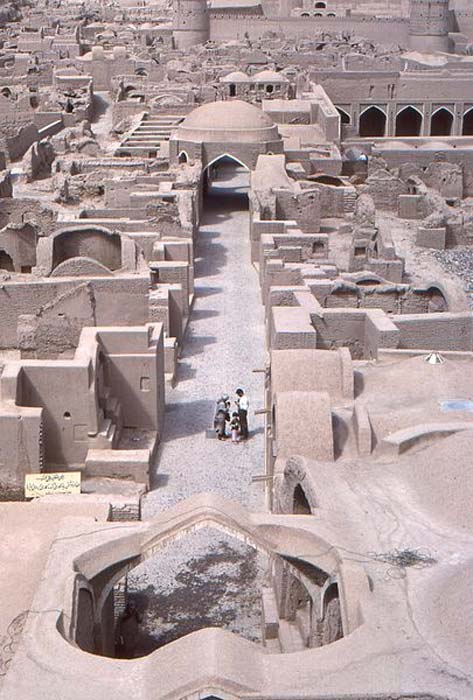
Arg-é Bam: An Ancient Citadel Destroyed By Nature and Reconstructed By Humanity
Arg-é Bam is a citadel located in Bam, a city in the Kerman Province in the south-eastern part of Iran. This citadel was built entirely out of adobe unbaked clay bricks, and it is often regarded as the largest structure built with this material in the world. In 2003, a powerful earthquake struck the city of Bam, and much of the citadel was destroyed.
The Iranian authorities, with the help of several other countries, have worked to reconstruct the site following that disaster. It has been estimated that the project to restore Arg-é Bam will be completed in 2017.

Bam and its cultural landscape. The ruins of Arg-é Bam are in the background. (UNESCO/CC BY SA 3.0 IGO)
An Achaemenid Fort
No precise archaeological dates are currently available to pinpoint the exact age of Arg-é Bam. However literary sources record that a fort had been built there by the Achaemenids at some point of time between the 6th and 4th centuries BC. Some archaeologists have even compared certain features of the citadel to the Achaemenid city of Persepolis to show that the fort was indeed built during the same period.
During the Parthian period the fort was expanded and became a citadel. At the end of the Parthian period, Arg-é Bam was captured by Ardashir I, the founder of the Sassanian Empire. The Sassanians constructed new fortifications and walls.
- The 4,000-Year-Old Abandoned Mud-Brick Town of Kharanaq, Iran: A Photographic Look
- The Ancient Site of Takht-e Soleyman: Iran’s Throne of King Solomon
- Human Tragedy Revealed at ancient city: Excavations uncover mass grave at Heft Tappeh, Iran

A coin depicting Ardashir I. (Magnus Manske/CC BY SA 3.0)
Bam’s Golden Age
The 7th century AD saw the rise of a new religion in the Arabian Peninsula - Islam. By the middle of the 7th century AD, the Arabs had destroyed the Sassanian Empire. Much of modern day Iran, including the Kerman Province, was conquered by the Islamic armies.
It was during this period, from the coming of Islam until the 11th century AD, that the city of Bam was at its peak. A 10th century Islamic writer wrote that during these centuries the city was a well-established marketplace due to its location at the crossroads of important trade routes. The city was connected to Central Asia in the east, the Gulf in the south, and Egypt in the west. Additionally, Bam was surrounded by agricultural land. The city was also famous for its production of silk and cotton fabrics, its supposedly impregnable citadel (i.e. Arg-é Bam), its busy bazaars, and its palm trees.

A bazaar in Bam, Iran. (Patrickringgenberg/CC BY SA 3.0)
Arg-é Bam’s Architecture
In terms of architecture, Arg-é Bam has been regarded as a prime example of a structure built using the chineh (mud layers) and khesht (sun-dried mudbricks) technique. The citadel is often said to be the largest adobe structure in the world. Arg-é Bam covers an area of about 180,000 square meters (about 1,937,503 sq. ft.), and is surrounded by walls that were 6 to 7 meters (19.69-22.97 ft.) in height, and 1815 meters (5954.72 ft.) long.
The citadel may be divided into two parts – the first being the governor’s quarters, and the second being the fortified residential area. The former is located in the inner part of the fortification, and contains the citadel itself, barracks, and stalls for 200 horses (amongst other structures). The residential area surrounds the governor’s quarters and includes houses and public buildings.
- Preserved by Nature: Studying the Spectacular Salt Mummies of Iran
- The ancient city of Susa in Iran is a worldwide treasure
- The Longest Poem Ever Written: Shahnameh – The Epic Book of Kings

Arg-é Bam c. 1902. (Public Domain)
Rebuilding an Ancient Site
On December 26, 2003, a massive earthquake (6.6 on the Richter scale) struck the city of Bam. Between 26,000 and 32,000 lives were lost during that disaster. In addition, more than 80% of Arg-é Bam was destroyed.
Since then, several countries have been co-operating with the Iranian government to reconstruct the ancient citadel. Amongst these countries are Japan, Italy, and France. Japan, for example, has provided Iran with $1,300,000 US dollars for the reconstruction project, whilst France has given a map of the citadel to aid in reconstruction efforts.
Top Image: Arg-é Bam before the 2003 earthquake. Source: Charlie Phillips/CC BY 2.0
By Wu Mingren
References
Auroville Earth Institute , 2016. Bam and Arg-e-Bam, Iran. [Online]
Available at: http://www.earth-auroville.com/bam_and_arg_e_bam_en.php
Gray, M., 2016. Bam Citadel. [Online]
Available at: https://sacredsites.com/middle_east/iran/bam_citadel.html
Iran Review, 2009. Arg-é Bam, Bam Citadel. [Online]
Available at: Arg-é Bam, Bam Citadel
Islamic Republic News Agency, 2015. Arg-e-Bam restoration project to be completed by 2017. [Online]
Available at: http://www.irna.ir/en/News/81690687/?utm_source=twitterfeed&utm_medium=twitter
The Japan Times Ltd, 2013. Iran rebuilding famed Bam citadel. [Online]
Available at: http://www.japantimes.co.jp/news/2013/12/27/world/iran-rebuilding-famed-bam-citadel/#.WC9cArKLTcd
UNESCO, 2016. Bam and its Cultural Landscape. [Online]
Available at: http://whc.unesco.org/en/list/1208















